Continue reading previous part
In the last four parts of this article we covered air defence warfare, electronic warfare (EW), under-sea warfare, strike warfare and air operations. In this concluding part, let us take a look at command and control (C2) operations as well as cruise control operations.
Radars—A revisit
All surveillance and navigation radars are situated high up in the mast. In the age of sail ships, observers used to sit high up in the mast. Who can forget the observers ringing the bell after seeing the iceberg in the movie Titanic? Radars sitting high up in the masts give a greater radar horizon. Radar horizon is the maximum range at which radar can detect a target against the curvature of earth.
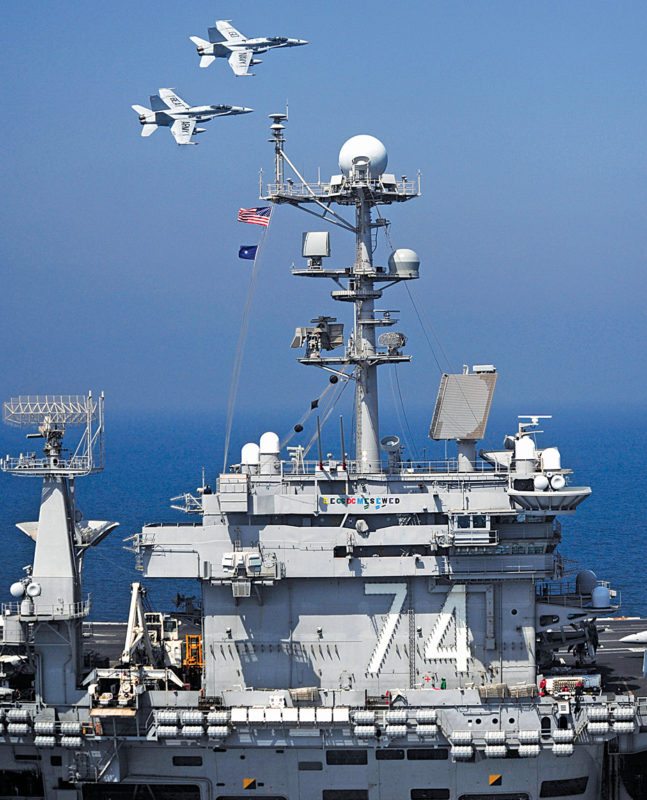
But presence of so many communication and detection equipment in the mast in interference. This requires certain systems to be turned off when another system is working. If the turned-off system is an important system, and if the enemy knowingly or by chance chooses to attack during this window, the result can be catastrophic.
C2 operations
Whatever may be the strength of force, it is only the right commands given at right times can make the force lethal. The commander who commands the carrier strike group (CSG) must know what is happening around him, the strengths and the weaknesses of the group.
For example, what will happen if the commander issues a command to launch a surface-to-air missile (SAM) when stocks of SAM have been exhausted? He must know the threats and his capabilities, and must be present in the carrier to command the CSG.
For effective command, the commander requires an efficient C2 system. Backbone of C2 systems is the communication systems that include voice links and datalinks.
Communication systems
The mast of the carrier is littered with numerous antennae—protected by radomes—for various communication systems and datalinks present in the CSG. Almost all sorts of antenna systems are seen in the carrier right from whip antennae situated in the flight deck to wire-fed fan antennae present above the superstructure. A plethora of communication systems operating at various frequencies and following various techniques of transmission could be found in the CSG.
Terrestrial radio communication. It has both military and non-military radio communication facilities operating in MF, HF, VHF and UHF bands. Military communications are secured through encryption and are used to communicate with CSG members. Even if the enemy intercepts military communication, they will not be able to understand the message.
VHF is used for ship-to-ship or helicopter-to-ship communications. Military HF and MF have a range of around 300km. VHF and UHF, due to their high-frequency-induced attenuation, have a range of around 100km.
Non-military radio communication is not secure. It is used to communicate with harbours, ships and aircraft of civilian or neutral origin. Non-military UHF systems can be used up to a range of 50km; all other band systems have the same range as that of their military counterparts.
Satellite communication systems. Aircraft carrier, being the commanding ship of the CSG, has a variety of dedicated satellite communication systems for various purposes. Long-distance communications are carried out through the USA’s defence satellite communications system (DSCS), a dedicated satellite based communication network. This high-capacity global system uses SHF band geo-stationary communication satellites that orbit equidistantly around the world.
On the other hand, short-distance communications are managed by fleet satellite communication (FLTSATCOM). Typically, this type of communication is between two CSGs or intra CSG communication or shore-to-CSG communication.
Satellite communication is carried out in two modes: receipt and broadcast. Receipt mode requires the recipient to send an acknowledgement message for each message it receives. Whereas, broadcast method, also called do-not-answer mode, does not require an acknowledgement message.
In the latter mode, the CSG can keep on receiving the data that are sent to it. The great advantage is that the CSG can preserve radio silence. Because, the moment it sends an acknowledgement message, the enemy electronic support measure (ESM) systems can find the CSG’s location. Through this mode, the CSG can receive situational updates without revealing its position.
Tactical digital information links (TADIL)
These tactical datalinks are the bridge between C2 systems of individual ships. Through these datalinks, Aegis ships exchange data between them and also with the carrier, so that overall C2 is maintained.
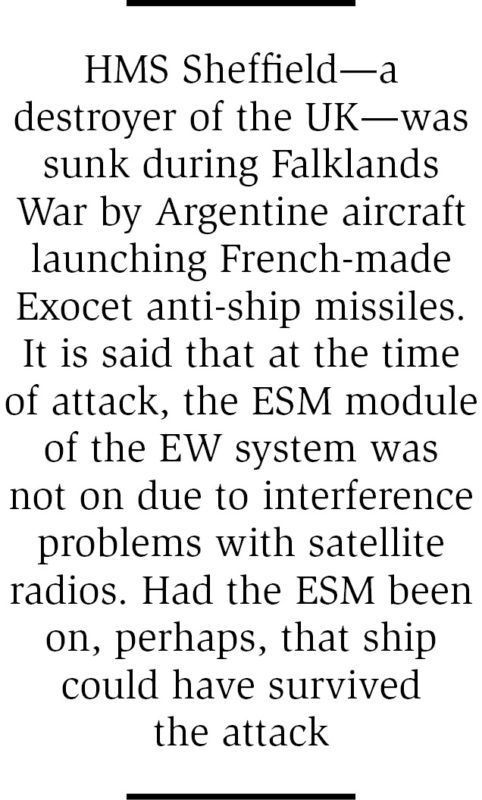
Link-4A. When airborne early warning (AEW) aircraft detect incoming enemy bomber, F-18 aircraft on patrol are instructed to fly towards the general area of the incoming enemy bomber. On reaching the area, these are vectored (giving directional commands) to intercept the bomber.
These are vectored through a datalink. The aircraft computer display in the pilot’s head-up display (HUD) shows the waypoints to be followed to intercept the bomber.
Link-4A is one such data link. It is a non-secured two-way datalink used for providing vector commands to combat aircraft. It operates in UHF band at a data rate of 5kbps. It follows time-division techniques. Also, aircraft are communicated during the following processes: automatic carrier landing system (ACLS), air traffic control (ATC) and during combat strikes.
Generally, Link-4A’s transmissions are not secure and could be jammed by enemy ECM. On the positive side, it is considered easier to operate and maintain. Because of these reasons, this very old datalink is still being used by the US Navy. In a carrier, there are ten channels for this link and the typical range is as far as 500km.
Link-11. Link-11 is a half-duplex high-speed encrypted datalink. It operates in HF and UHF bands. It facilitates computer-to-computer digital data communication between aircraft and ships. Even if the signals are intercepted by the enemy, these cannot be understood by them because of the encryption. Data can only be decoded at the receiving terminal.
Positional information of the transmitter is also sent along the data so that the receiver can know the sender’s position. This feature is an important aspect of combat communication. Typically, data sent by a ship to the aircraft is received by appropriate receivers in the aircraft. There, these are decoded by decoders and sent to the aircraft computer.
Then, information is displayed to the pilot in a format that he or she can understand. Data can be anything like waypoints that have to be followed for reaching the new destination or positional data of the enemy combat aircraft.
Combat aircraft have an electronic system called moving map display, which displays the map of the terrain over which the pilot flies. As the pilot flies ahead, the map also scrolls up accordingly. Waypoints are updated in the display through this datalink. In the carrier, there are 62 Link-11 datalink channels available. Each datalink is capable of communicating as far as 300km.
Link-16. Link-16 is a node-less, jam-resistant, high-speed, encrypted digital datalink. It operates in 960MHz-1215MHz band. Based on TDMA technique, it is used by aircraft, ships and even ground forces to exchange their tactical pictures in near-real-time.
Typically, commanders of the CSG at sea can even get tactical pictures around ground forces operating deep inside enemy territory. Link-16 supports exchange of text messages, imagery data and provides two channels for digital voice communications with a data rate of 2.4kbps and/or 16kbps in any combination. The range is around 500km and there are 255 Link-16 datalink channels available in the carrier.
Officer-in-tactical command information exchange sub-system (OTCIXS). This is a two-way UHF satcom based datalink system for intra- and inter-CSG communication. This link supports the exchange of targeting information for multi-targeting of sub-surface, surface and aerial targets. A ship can get radar track data from other ships through this link even while not using its radar at all. This is called over-the-horizon (OTH) targeting.
Tactical data information exchange sub-system (TADIXS) downlink. This is a shore-to-ship one-way satellite datalink for the ships to receive mission plans for launching Tomahawk Land Attack Missiles (TLAMs).
Sonobuoy datalink. This datalink connects sonobuoys with the under-sea warfare system present in destroyers. These dispensable sonobuoys are dropped by the submarine hunting helicopters in the areas suspected with enemy submarine activity. The under-sea warfare system deduces the submarine scenario through these datalinks.
C2 systems
In a carrier, the storey above the flight-deck is called flag bridge. Commander of the CSG controls all operations from a command centre called tactical flag command centre (TFCC), situated in this bridge. In naval parlance, flag indicates something related to the commander of a fleet.
Commander of the CSG gets instructions from his high command through a satellite based C2 system called global command and control systems-maritime (GCCS-M). Through this system, commander of the CSG provides situation reports to his high command.
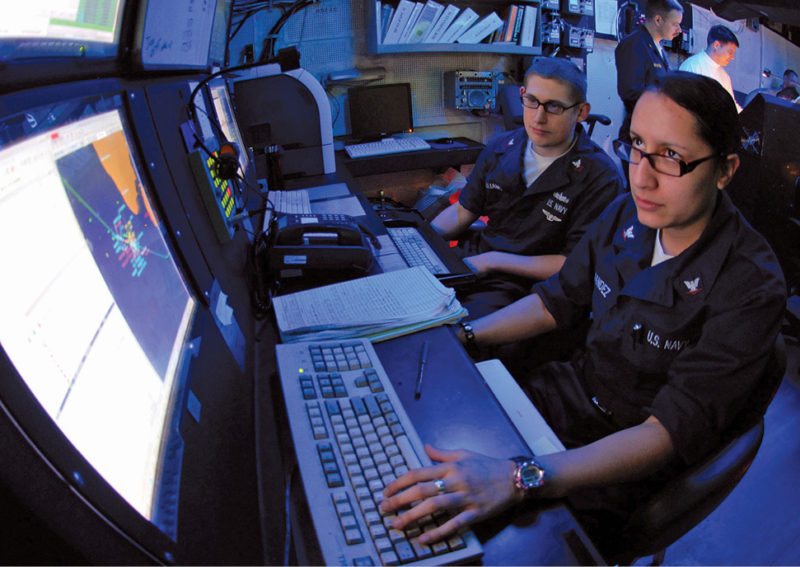
A system called advanced combat direction system (ACDS) creates the tactical picture around the CSG. Display of the ACDS gives the CSG commander the tactical picture around the CSG for taking combat decisions.
Similarly, captain of the carrier has another parallel ACDS display at his command centre called combat direction centre (CDS) from where he or she gets the tactical picture around the carrier.
Global C2 systems-maritime (GCCS-M). GCCS-M is a system that receives, processes, displays and manages data on the readiness of neutral, friendly and hostile forces in near-real-time. It does this via external communication channels, local area networks and direct interfaces with other systems. Any information the CSG commander required for the mission, be it intelligence or meteorological data, is sent through this system from the higher ups. It is through this GCCS-M system that the commander of the CSG takes orders from the higher command and passes situation reports to the higher command.
For a CSG commander, GCCS-M aids in the decision-making process by displaying relevant tactical information. For example, the CSG is anchored 300km from enemy shore. Job of the CSG is to neutralise an enemy nuclear missile base situated 200km inland. The condition for neutralisation is that the missile base readies itself for a nuclear missile launch. But, how will the CSG commander know that the nuclear missile base is ready for missile launch?
This information can only be gathered by people of the likes of a man drinking a Vodka Martini and who is addressed as 007. Purely, the data he collects is intelligence related. Such information is not available through the CSG’s resources for the CSG commander. So in this case, intelligence has to be supplied by the high command to the CSG commander.
If the enemy nuclear missile base readies for a missile launch, the CSG commander is issued an order to neutralise that base. This is done through GCCS-M. For such information exchanges, datalinks TADIXS and OTCIXS play a vital role.
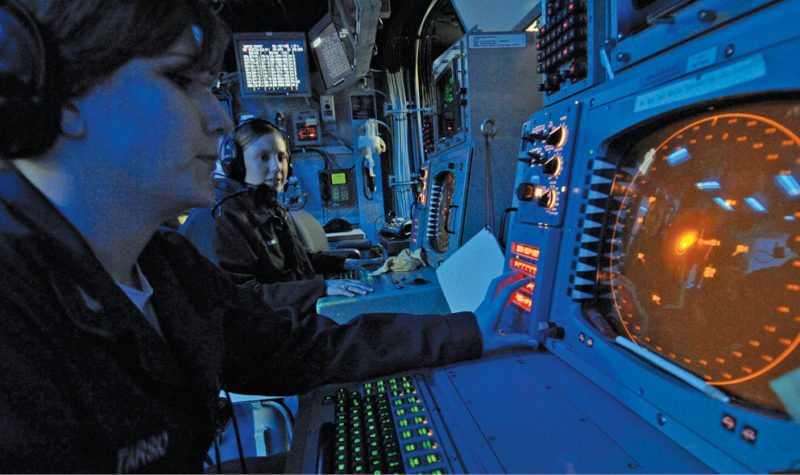
The CSG commander can also access information through special wireless Internet systems. CSG is a node in secure internet protocol router network (SIPRNET), non-secure internet protocol router network (NIPRNET) and joint worldwide intelligence communication system (JWICS).
SIPRNET is a military Internet system owned by Department of Defence (DoD) of the USA. It has only restricted access. Through this Internet, classified information is passed through packet switching.
NIPRNET is a type of Internet that is used to exchange sensitive but non-secret information between privileged users and at the same time provides them Internet access. Again, Internet Protocol routers are owned by DoD of the USA.
JWICS is DoD’s, top-secret version of the Internet, together with its secret counterpart, SIPRNET.
Previously, GCCS-M was implemented through high-performance UNIX workstations because of their capability to run GCCS-M specific software. The trend of availability of increasing computing power and increasing software versatility is leading to a migration of GCCS-M towards off-the-shelf systems.
ACDS. This is a centralised, automated C2 system. It is used to collect and correlate combat information on the air, in the surface, sub-surface and EW environments. It acts as a central repository of all tactically significant targets (detected by radars and sonars) for the CSG.
ACDS is a comprehensive system and contains many computers, a display system with many consoles. It integrates on a mainframe computer the information from carrier’s sensor systems, datalinks, navigation/air traffic control systems and weapon systems. This system is operated by 23 crew members.
Computers running application-specific software collate and correlate data. All surface and air search radar tracks and sonar tracks are communicated to the ACDS by Aegis ships of the CSG through datalinks. The respective ships derive their coordinates from their navigation systems called inertial navigation system, cross referred by a GPS.
This they send with their identification data while sending track data. ACDS, after receiving all data, correlates it with various similar tracks and positional coordinates of that ship. For example, two ships present in the CSG but sailing at different locations might have sent track data of the same enemy aircraft to the ACDS. In reality, these tracks are nothing but the track of the same aircraft taken from different locations.
ACDS, after correlation, classifies that track as the same aircraft by comparing the positional coordinates sent by the ships. This is called grid-locking. Like this, the ACDS displays the tracks accordingly to provide an overall tactical picture around the CSG. This gives the CSG commander the capability to identify targets, classify these and prioritize threats for easy decision making.
Based upon the threat, the commander initiates engagements like vectoring combat aircraft to targets, or launching SAM from a destroyer, or launching anti-ship missile from a destroyer.
Generally, all constituent ships of the CSGs are delegated with responsibilities to deal with threats occurring in their sectors. In one Aegis cruiser, the air defence command centre of the CSG, there is an air defence warfare commander working full-time. His or her commands are executed by the captains of Aegis cruisers and destroyers.
Similarly, there are commanders for underwater warfare, surface warfare, EW and strike warfare. The CSG commander can also exchange targeting information and engagement orders, not only within his or her CSG but also with other CSGs.
Cruise control operations
Cruise control operations involve navigation and propulsion operations. They are carried out in a similar way as commercial shipping navigation.
Navigation. Navigation was done through compass in the olden days; then emerged sextants and printed navigation charts. These printed navigation charts are like a detailed map but for sea routes, and indicate depth of a certain area in the sea, width of straits and other information. Now, these charts are the tools of the past and are only used as a fallback option today. Their roles have been taken over by a system called electronic chart display and information system (ECDIS), which takes inputs from electronic navigation charts (ENCs) and displays the area of interest.
These ENCs have complete hydro-graphical information like navigational hazards, depth of a particular place, width of the navigable channel and a lot more, as electronic data.
GPS is used to find out the precise position of the carrier and other ships. This positional information is fed to the ECDIS, which displays all relevant data so that the navigator gets the complete idea of his or her position and surroundings.
Radar AN/SPN-67, which is also used in a ship self-defence system (SSDS) is used for navigation. Along with this radar, a radar called AN/SPS-64 is also used for navigation. This radar operates on a fixed frequency of 9GHz and has a peak power output of 20kW. Its antenna can rotate at speeds up to 33rpm, which provides a high degree of target resolution and also allows target information update for every two seconds.
After detecting contacts through this radar, a system called automatic identification system (AIS) helps in identifying the nature of the contact. AIS is a system that all sea-going non-military vessels must possess. It relays its identification in radio frequency (like identify friend or foe, or IFF).
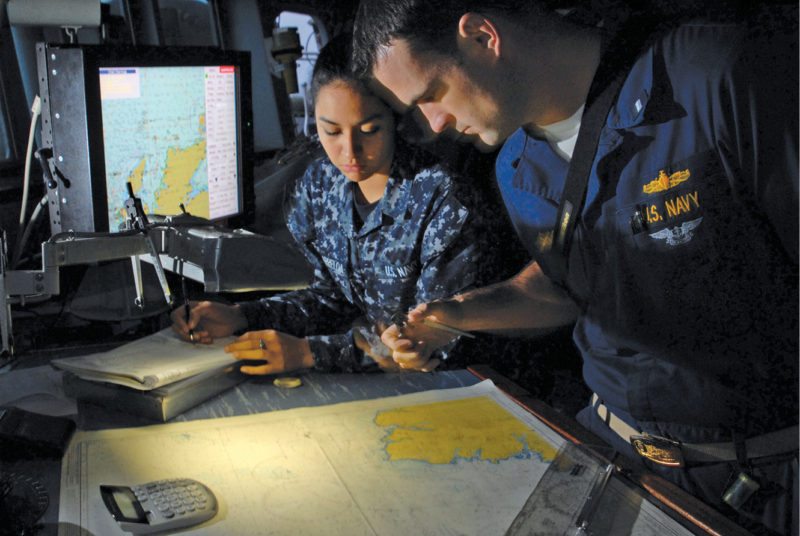
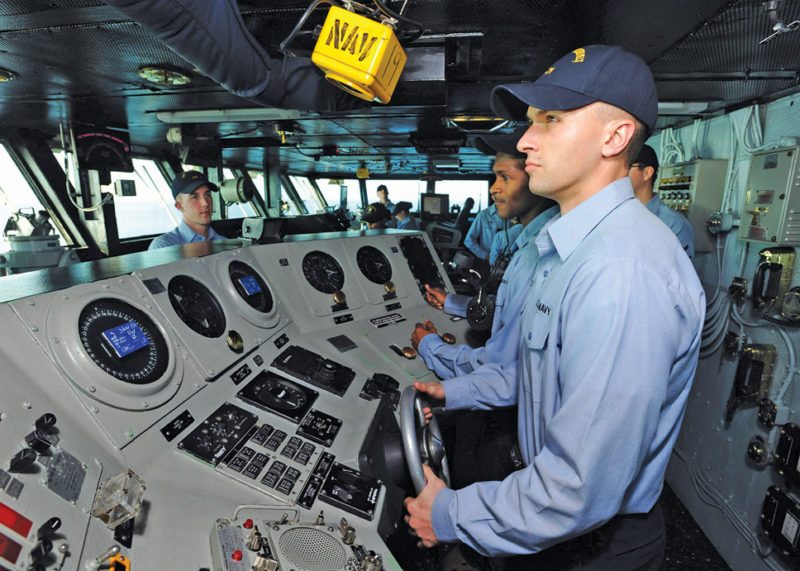
Generally, the required instructions for navigation are given by the captain from the combat direction centre (CDC). Necessary information like a copy of navigation radar displays is available at the bridge, which is the command centre for sailing the carrier. This bridge is the first storey above the flight deck. From here, sailors called helmsmen, control the sailing operations. Aegis escorts also have similar navigation radars and helmsmen controls.
Propulsion. The next part of Cruise control operation is Propulsion. A carrier’s propulsion power comes from the electricity generated from two scaled-down nuclear reactors. These produce a shaft horsepower of 140MW to drive propeller shafts. Electronic systems that are used in controlling the nuclear chain reaction and associated functions of normal reactors are also found in the carriers.
These reactors can work continuously for 20 years without requiring any refuelling. With the aid of these reactors, carriers can reach speeds of 55kmph with ease. In naval parlance, sailing at this speed is like driving a Formula One car, and almost 100 thousand tonnes of mass sailing at this speed is something unimaginable.
Other vessels of the CSG are not nuclear powered but are powered by diesel-fuelled gas turbine engines. Controls of these propulsion systems also resemble industrial-class designs with military standard.
Thus cruise control operation is carried out.
Russian carriers: The other side of the coin
Definitely, American CSGs are a force to reckon with. But one cannot forget Prince Hector or Karna while speaking about Achilles and Arjuna, respectively. So, such a detailed literature on American carriers will not be complete without mentioning the Russian carrier force.
Traditionally, Soviet Navy’s and later Russian Navy’s speciality is that these are a submarine dominant forces. Though there are very much capable surface vessels in their navies, dominance of their submarines is greater. As water is the best antidote for fire, submarines are a perfect match capable of standing toe to toe with the CSG. But it did not restrict Soviet Union to try its part on carriers.
Basically, pioneers in naval technology are Britons. British Empire sustained with the strength of their navy. World’s first carrier, HMS Argus, was a British ship. Many of the novel naval innovations are theirs, such as radars and sonars. After the 1970s, the UK restricted itself to small carriers with aircraft, known as Harrier, capable to take off vertically.
Britons installed a ramp called ski jump at the edge of the carrier. Harriers run through this ramp to get air-borne. Indian Navy is also operating such a carrier called INS Viraat and a handful of Harriers.
Strangely, Russians clubbed American and British practices. Russian aircraft take off by running through the ski-jump like British, and land by tail-hooking arrestor wires like Americans. But Russian carriers are not meant for strike operations. Their purpose is to protect Russian nuclear submarines that carry nuclear warheaded intercontinental ballistic missiles (ICBMs) from the American long-range anti-submarine aircraft.
Russian carriers are designed entirely to operate alone unlike American carriers. The present Russian carrier Admiral Kuznetsov has the features of an entire CSG, but is scaled down. The carrier has a dozen or so fighter aircraft, sonars, early-warning helicopters and even phased array radars like American Aegis ones. There are also anti-ship cruise missiles (also with land-attack capability) to hit targets at a range of more than 500km. It is the most-protected carrier in the world. There are eight AK-630 close in weapon systems (CIWSs). There are 192 3K95 Kinzhal ready-to-be-fired SAMs of 15km range and capable of being launched every three seconds.
Apart from this, there are eight Kashtan CIWS-SAM combos. One combo contains two guns and 32 ready-to-be-fired 3K87 Kortik SAMs. So in total there are 24 CIWS and 192+256 SAMs.

Literally, these systems form a defensive bubble around the carrier against cruise missiles and also aircraft. A Soviet-era carrier called Admiral Gorshkhov even had an automatic landing system to guide their now-retired Yakolev-41 aircraft, Soviet’s answer to British Harriers.
This very same carrier has entered the Indian Navy as INS Vikramaditya and will serve the Indian Navy in the years to come. The carrier was intensively modified and refurbished for the Indian Navy. Now, it has become almost 80 per cent new. It also has an automatic landing system and will be getting a capable air defence system.
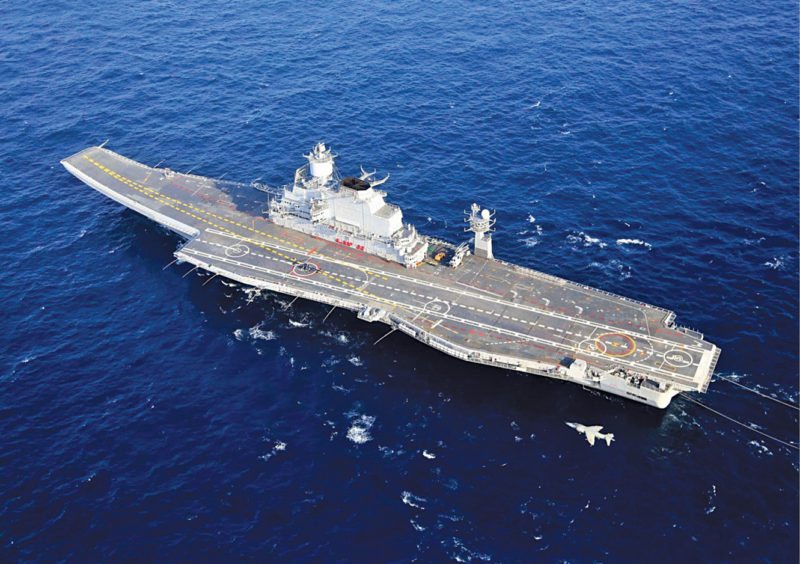
The CSG so far has been thinking about ways to tackle cruise missiles. But the Chinese development of a ballistic missile called DF-21D has changed the basics itself. This missile is said to have been developed to specifically target US Navy’s CSGs. This ballistic missile will re-enter the atmosphere after its post launch flight through space.
Until this point, there is no difference between this missile and other ballistic missiles. But this DF-21D—after re-entry—will open its target seeker and look for the carrier. The enormous size of the carrier’s fight deck will be spotted by the seeker. The missile will then descent towards the carrier at a speed of 5-mach to 6-mach. At such speeds intercepting it will be very difficult. In the years to come, it will be interesting to see what the Americans are going to do to counter this missile.
In short, it is an eternal duel between Aircraft carriers and the means to counter aircraft carriers. As long as the carriers remain in the scene, this duel will be on. As long as this duel goes on, both sides will use intelligent electronic systems as their weapons.
B. Kamalanath is a technical writer. He is also a research scholar, pursuing Ph.D in military technology







